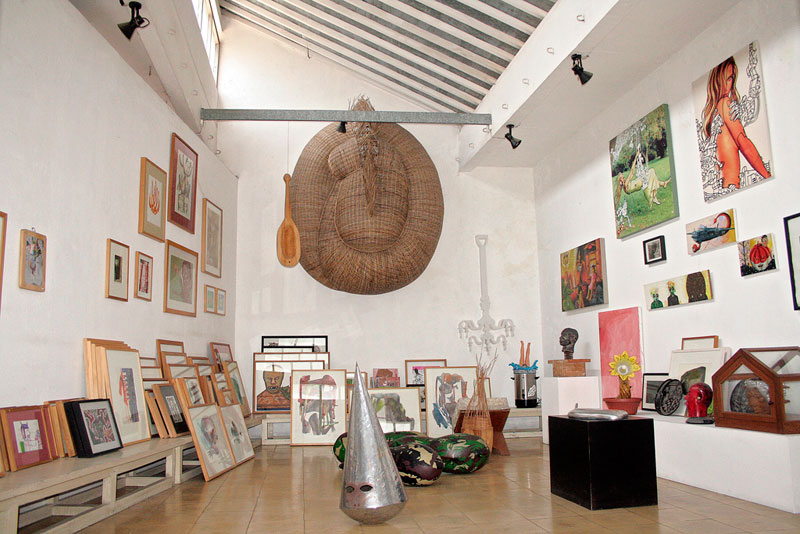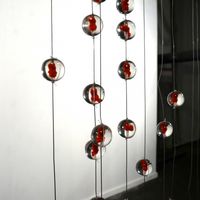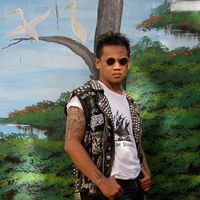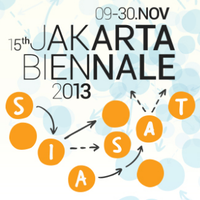Turning Targets: 25 years of Cemeti Art House

culture360.org Writer Katerina Valdivia Bruch shares her artistic experiences in Indonesia and interviews the artists and founders of Cemeti Art House: Mella Jaarsma (MJ) and Nindityo Adipurnomo (NA).
--
In December 2008, I came to Indonesia for the first time. Once there, I did not know much about what I would find in terms of artistic practice. During three months, I was living in the artist run space MES56, composed by a group of photographers, in the city of Yogyakarta. At that time, the arts scene in Jogja (another word to say Yogyakarta) was vibrant with artist run initiatives that were presenting exhibitions, artist talks, organising workshops, offering music gigs or concerts of electronic music and performances. The majority of the events were organised by artists and arts practitioners, due to the lack of public infrastructure for contemporary arts.
The first exhibition I visited was Java's Machine: Phantasmagoria by Jompet Kuswidananto that deeply impressed me for its multidisciplinarity and its reflection on Java as a melting pot for different cultures. Historical facts were combined in an interactive sound and video installation, together with an on-site performance by the actor Bahrul Ulum from Teater Garasi and Risky Summerbee, leader of the band Risky Summerbee and the Honeythief, who performed during the opening. This show was presented at Cemeti Art House, an artist initiative established in 1988 by Mella Jaarsma and Nindityo Adipurnomo, that has just celebrated its 25 years of existence on 31 January 2013.
Cemeti promoted contemporary Indonesian art overseas doing collaborations with international institutions and residency programmes. This institution organised a variety of courses, workshops, talks and lectures on current local and global issues. What distinguishes Cemeti is its commitment towards a reflection on art and society. In 1995, they developed an archive about Indonesian contemporary art under the umbrella of Cemeti Art Foundation and were pioneers in establishing discussions not only about local concerns, but also beyond Indonesia's boundaries. Cemeti is one of the few places to find art discourse in Indonesia, something that is a bit lacking nowadays due to market oriented forces.
INTERVIEW
1. Besides playing a pivotal role in the development of Indonesian contemporary art and opening a path to the internationalisation of it, which are the major achievements that you can recall from these 25 years?
MJ/NA: One of our achievements is the organisation of exhibitions with quality works pushing the borders of Indonesian artists’ creativity - which means to professionalise artists, bringing them further in their careers by promoting and guiding them during their creative processes, helping/recommending them for further studies, residencies and exhibitions in other places and countries. Another accomplishment is to be able to create awareness about different forms and functions in the arts, to expand networks reaching wider audiences and communities and advocate the importance of the arts to the public and (government) institutions. We are also glad to have been capable to use art as a tool for educational developments in Indonesian society, amongst other projects.
2. When you started Cemeti Art House, there was a particular need to connect Indonesian art to a global art discourse. During that time, Indonesia was ruled by the New Order era under Suharto's dictatorship. In fact, the artists you were working with had strong socio-political works. Later, during Indonesia's Reformasi (after the downfall of Suharto in 1998) and the new democracy, you were enganging artists with other social topics, such as environmental issues during the exhibition series Bocor (Leak) or reflecting on Indonesian history in the exhibition Masa Lalu, Masa Lupa (The Past, the Forgotten Time). How do you relate today to art and society?
MJ/NA: We still develop and stimulate projects that are related to education and discourse, from environmental to political issues. Currently, we are involved in Koalisi Seni Indonesia (Indonesian Art Coalition) bundling different art organisations for advocation with the aim to create an endowment funds for the arts. We need to support creative stimulation to keep different artforms alive, and to influence critical discourse and perspectives. Responding to this shift, around twenty art organisations from various disciplines such as dance, theatre, film and art management have bundled their strengths and founded Koalisi Seni Indonesia. The Coalition aims to establish a national peak body for the arts that can advocate for the importance of art in our lives and in society at large. This means, that we are not only dealing with the public or specific communities, but also approaching government bodies to develop fundings for the arts, which was lacking so far.
3. Since its very beginning, Cemeti has been interested in promoting art discourse and reflecting on art and society in Indonesia. In 1995, you founded the Cemeti Art Foundation establishing an archive about Indonesian contemporary art, that became independent in 2007 and is now the Indonesian Visual Art Archive (IVAA). Is there any art historian or curator from Indonesia, that started his or her career thanks to this archive?
MJ/NA: In 2007 only the name changed. In 1995, when we initiated the Cemeti Art Foundation we needed the Cemeti name in order to get the trust to receive fundings, but from the beginning we did not put Cemeti Art House under the umbrella of the foundation. Today, they are two separate organisations and we [Mella and Nindityo] are both still in the board together with six other members of IVAA. We changed the name because of the confusion and we did not need the trust anymore after twelve years.
It is hard to claim if curators developed from there, but for some of the curators this archive has contributed toward their development. Up until now, the strongest curators do not come from Jogja, but it has helped writers and curators like Nuning [Nuraini Juliastuti - former Director of KUNCI Cultural Studies Center] and Alia [Alia Swastika - independent curator].
4. Your experience in the field has opened the door to a number of artists that now have an international career. The term 'Cemeti artist' is a sign of quality nowadays. In which way are you still working with these artists?
MJ/NA: With quite many we still have close contact, also because we are colleagues and meet each other in international exhibitions and developed together. But the reality is that we work more intensively with younger artists. So, once the artists are established and absorbed by the commercial or international circuit, they don't need Cemeti and we move on with a new generation. Although, depending on the project, we still invite those artists who already worked with us and ask them to collaborate in educational projects or workshops.
The changes in the generations have also changed the focus of how Cemeti Art House works. When we started in 1988 the focus was on promoting Indonesian artists nationally and internationally. In more recent years, we have shifted to provide artists with the opportunity to work independent of commercial forces through residencies and other programmes offering them space and time to develop their practice. The question whether young artists in post-dictatorial Asia are only engaged in safe, playful, non-critical consumer art has been raised. Although young artists tend to produce commercial ‘art objects’, the art scene seems as vibrant as ever, yet the function of art may have changed in ways which question Indonesian artists’ influence on the international art scene in the future.
5. With your residency programmes, you have established a bridge between Indonesia and the Netherlands, Australia and other Asian countries, and currently the rest of the world. One of the most interesting programmes connecting Asia and Europe was the Landing Soon artist in residency between Indonesian and Dutch artists. Today, Cemeti offers a place for different kinds of residencies: since 2010, the Hot Wave residency puts together 3 artists from 3 different countries, but you also have a residency for curators, arts managers and writers. What are your future projects related to these exchange programmes and what are the aims of these initiatives?
MJ/NA: Doing more research projects and exhibitions like the Dobrak and Pseudo Participative Project [both projects are part of the Turning Targets programme of events during this year], connecting visual arts and research, but still working with residencies, although we will probably look for a different module.
6. Which anecdotes would you like to share with us from these 25 years?
MJ/NA: Too many...
7. Cemeti Art House celebrates its 25 years with Turning Targets, a year long programme. A good way to reflect about the past and future of contemporary art in Indonesia. How do you see the arts scene now and how would you like to continue working in this field?
MJ/NA: The flow of creative energy keeps us going and makes us want to learn from the past and develop concerning the conditions in Indonesia. That it is very important: to be low profile and relate to the local circumstances, with a local public and a fast changing society and at the same time facilitate information to the international art world.
It is ironic that while today’s art is becoming less exciting and provocative, we are simultaneously witnessing increased attention from a wider audience. At the opening of ART/JOG12, an art fair with artists but no galleries held in Yogyakarta in July 2012, more than 1,000 people queued up during the opening night. Contemporary art is the latest trend in Indonesia; youngsters love to photograph themselves in front of artworks and then post the pictures on Facebook. Local interest from young collectors is also promising. However, considering the increased commercialisation of Indonesian visual art, there should also be a greater emphasis on critical discourse.
Thanks Mella and Nindit for the interview. Let's celebrate with Cemeti for many more years!
---
The author wants to publicly express her sincere gratitude to Mella Jaarsma, Nindityo Adipurnomo and the Cemeti Art House team for their unconditional support during her research periods in Indonesia.
* Information in [ ] are notes by the author
Katerina Valdivia Bruch is a Berlin-based independent curator and art critic. She has curated exhibitions for a number of institutions, including ZKM-Center for Art and Media Karlsruhe, Bielefelder Kunstverein (Bielefeld), CCCB (Barcelona), Instituto Cervantes (Berlin and Munich), Instituto Cultural de Leon (Mexico), Para/Site Art Space (Hong Kong), and the Institute of Contemporary Arts Singapore, LASALLE College of the Arts. In 2008, she was co-curator of the Prague Triennale at the National Gallery in Prague. Besides her work as a curator, she contributes with essays and articles for art publications and magazines. Since 2009, she has organised a number of talks and exhibitions on Indonesian contemporary art.
www.artatak.net
Similar content
posted on
20 Dec 2012
posted on
06 Sep 2010
from - to
09 Nov 2013 - 30 Nov 2013
deadline
31 Jan 2013






